Static Friction: Why It Costs More Energy to Start Than to Scale aBusiness
Stuck in "pre-launch"? Moving from employee to founder requires breaking static friction. Learn the 5 strategic shifts to build a sustainable business today.

In physics, Newton’s First Law states that an object at rest stays at rest unless acted upon by an unbalanced force. This is the Law of Inertia.
In the pre-launch phase of a business, that "object at rest" is you.
The "rest" state is comfortable. It’s your ₹30,00,000/year salary. It’s the safety of the monthly paycheck hitting your account on the 30th. A few years into a corporate role, we gain a sense of safety in this predictable rhythm. We enjoy the luxury of complaining about our manager without having to bear the burden of being the manager.
To move from "rest" (employee) to "motion" (founder) requires an unbalanced force. Breaking static friction always requires far more energy than maintaining kinetic friction.
Most people think starting a business is about tactics: filing the paperwork, buying a domain, opening a bank account, or designing a logo. These are easy. These are fake motion.
During my MBA, I learned that "Strategy" is an action taken to attain organizational goals. In practice, I just ended up making to-do lists. The real lesson I learned over the last few years—painfully—is that strategy isn't about what you do. Strategy is the hard work of choosing what not to do.
If you are standing on the edge, terrified to quit your job, or you’re running a side project doing ₹50,000/month and wondering how to scale, stop looking for "hacks." You need to change how you think about the war you are about to enter.
Here is the strategic architecture of the start.
Define the Enemy (It’s Not Who You Think)
Reading The 33 Strategies of War, you can easily infer that the first requirement for any campaign is clarity on the enemy. A clear enemy creates focus.
When we start a business, we almost always pick the wrong enemy.
- We think the enemy is a competitor (e.g., "I’m going to beat Salesforce").
- We think the enemy is the government (taxes, compliance, bureaucracy).
Looking back at my own failures, I realized the true enemy is friction.
- Internal Friction: The "Gulf of Disapproval." This is the gap between your new idea and the validation you crave from friends and family. When you start, the number of people advising you against it will always outnumber those supporting you. If you need your college friends or your parents to "get it," you will quit before you start.
- Market Friction: When I took over my family business, the enemy wasn't other security firms. The real enemy was Chaos. The enemy was the "tyranny of spreadsheets" and old-school manual processes that made us leak profit as we grew.

The Mental Model: Don't sell a product; declare war on a problem. When you position yourself as fighting against a specific, painful problem (like bureaucratic drag or lost profit), you occupy the "moral high ground." You aren't just trying to make money; you are trying to restore order.
Your takeaway: Name the specific chaos you are killing. If you can’t name it, you aren’t ready to start.
Choose Your Game (The Finite vs. Infinite Trap)
One of the biggest mistakes I see "Pre-Launch" founders make is trying to play a game they cannot win.
They read about VC-funded unicorns and think they need to play the "Dominance" game—burning cash to capture market share. They try to replicate the tactics of a company with ₹500 crore in the bank while they have ₹5 lakhs in savings.
This is strategic suicide.
You must apply the "Perfect Economy" strategy. You have finite resources (time, money, sanity). You cannot afford a war of attrition.
- The VC Game: High risk, high capital, "winner take all," focused on exit.
- The Bootstrapper Game: Low burn, high control, focused on cash flow and sovereignty.

I chose not to play the VC game. I didn't want a boss, even if that boss was a board of directors. I chose the game of Sustainability.
Seth Godin talks extensively about the "Smallest Viable Audience." You don't need 1,000,000 users. You need "First, Ten." If you can find ten people who desperately need what you have, you have a business. If you try to please everyone, you have a hobby.
Your takeaway: Decide today: Are you building an asset to sell (an exit), or a machine to own (an income)? You cannot play both games at once.
The Death Ground (Manufacturing Urgency)
In The 33 Strategies of War, Robert Greene explains a concept called "Death Ground." When soldiers have no escape route, they fight with superhuman energy. When they have a way out, they hesitate.
Your corporate job is your escape route.
I know friends earning ₹2.5L/month in good roles who talk endlessly about their business ideas. But only 2 or 3 ever work on it. When I ask for updates, they share a generic pitch deck or a 20-page document generated by AI.
Why? Because they are on "Comfortable Ground," not Death Ground.

However, burning the boats is dangerous if you don't know how to swim. You do not need to quit your job tomorrow with zero revenue. That is not strategy; that is gambling.
The Calculated Death Ground:
- Set a Financial Tripwire: "I have saved enough to survive for 18 months. The day my side project hits ₹75,000/month consistently for 3 months, I quit."
- Set a Public Deadline: Tell your network you are launching on X date. Now, your reputation is the boat you burned.
- Invest Your Own Capital: Put enough of your own money into the business that it hurts to lose it.
I wanted to start something of my own since 2015 but rarely did anything. In 2018, I finally quit to start up. Looking back, it was a weak plan because I knew my father had an ongoing business and I was still subconsciously on "Comfortable Ground."
Due to his untimely demise in 2019, I had to take charge of the business he built. Suddenly, the ground shifted. I had payroll to meet and no investors coming to save me. I found a level of focus I didn't know I possessed because I had no other choice.
Your takeaway: You will never give 100% as long as you have a safe Plan B. Create a controlled crisis to force action.
Plan All The Way To The End (The "Manpower to Machine" Test)
In The 48 Laws of Power, Robert Greene clearly states: "The ending is everything."
Most of us plan for the start. We obsess over the launch day. We rarely plan for the success.
- What happens if you actually get 50 clients?
- Do you have a system to handle them, or will you just work 18 hours a day?
- Have you built a job for yourself, or a business?
This is the Manpower to Machine core story. In the early days of taking over the business, I was the "Manpower." My father had built systems that required him to manage daily operations—reviewing payroll calculations, handling client complaints, checking every invoice.
When I started, I nearly collapsed. We had revenue, but no scalable systems. The COVID lockdown provided me the forced pause I needed to develop better systems i.e to move from Manpower to Machine.

Before you start, ask yourself: "If this works, does my life get better or worse?"
If getting 10 new clients means you can't sleep, your strategy is flawed. You are relying on "Heroic Effort" (a bad strategy) rather than an "Elegant Path" (using systems).
Your takeaway: Don't build a prison and call it a startup. Design the system that replaces you from Day 1.
Ignore Sunk Clowns (The Economics of Emotion)
Seth Godin uses the metaphor of Sunk Clowns. You hire a clown for a party. He doesn't show up. You spent money. You spent emotion. But he's not there.
Do you spend the rest of the party crying about the clown? Or do you turn on the music and have a party?
In the early days, you will make mistakes. I spent over ₹50,000 on LinkedIn and Google ads and got zero customers. I spent 3 months developing a complex customer support system, a feature none of my customers use.
These are Sunk Clowns.

Initially, I wanted to double down on these "Non-Strategies" rather than admit I was wrong. I was defending my bad decisions to protect my ego.
Rationality eventually prevailed. I treated those costs as a gift from my past self—a lesson paid for. You aren't obligated to keep doing a thing just because you started it.
I once spent months negotiating a ₹48,00,000 monthly contract. It looked like a massive win. But when I ran the Pressure Equation (P=F/A), I realized the force of the client’s demands on the small surface area of my working capital would crush me.
I had "sunk" months of effort into that deal. Walking away felt like burning money. But the "sunk cost" was in the past; the bankruptcy risk was in the future. I walked away.
Your takeaway: A "wrong" decision isn't a moral failure. It's data. Don't throw good days after bad ones.
Summary: The Architect vs. The Bricklayer
Most people want to be the bricklayer. They want someone to tell them, "Put this brick here. File this form there."
That is a job.
If you want to start a business, you must be the architect. You must look at the empty lot and see the building before it exists. You must understand the physics of the market, the gravity of your cash flow, and the time it takes for the cement to dry.
- Name the Chaos you are fighting.
- Refuse the games you cannot win (VC/Status).
- Create a tripwire to force you off the ledge.
- Design the machine, not just the hustle.
- Kill your darlings (sunk costs) the moment they stop serving the mission.
The strategy isn't the goal. The strategy is the path.
Start walking.